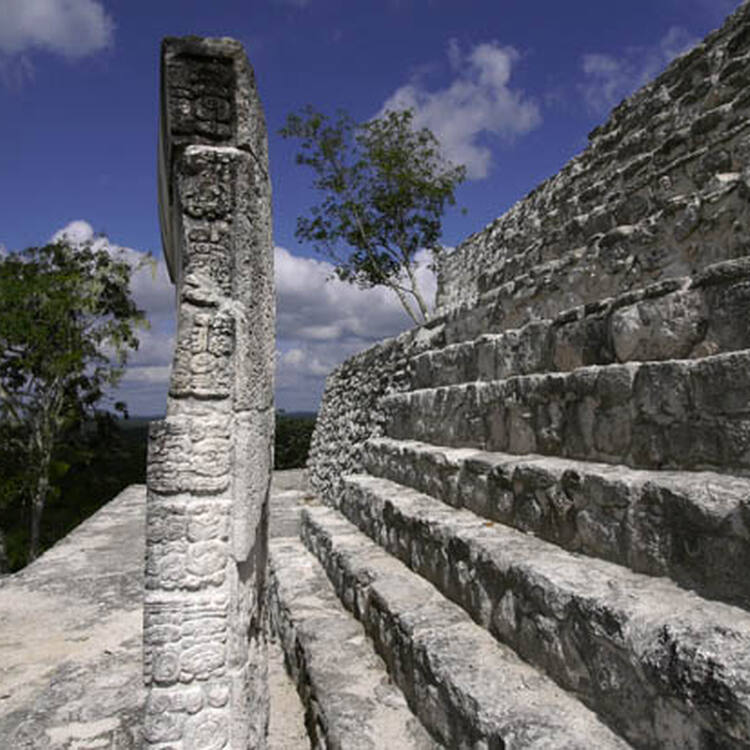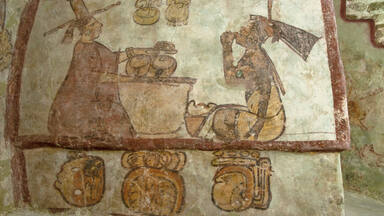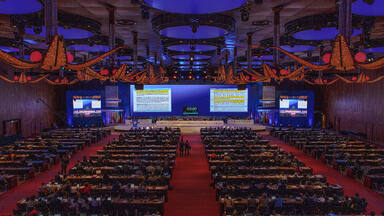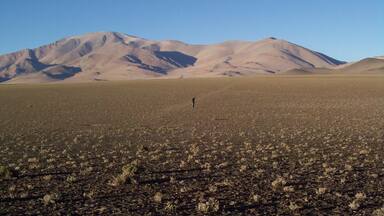Ancient Maya City and Protected Tropical Forests of Calakmul, Campeche
Ancient Maya City and Protected Tropical Forests of Calakmul, Campeche
The site is located in the central/southern portion of the Yucatán Peninsula, in southern Mexico and includes the remains of the important Maya city Calakmul, set deep in the tropical forest of the Tierras Bajas. The city played a key role in the history of this region for more than twelve centuries and is characterized by well-preserved structures providing a vivid picture of life in an ancient Maya capital. The property also falls within the Mesoamerica biodiversity hotspot, the third largest in the world, encompassing all subtropical and tropical ecosystems from central Mexico to the Panama Canal.
Description is available under license CC-BY-SA IGO 3.0
Ancienne cité maya et forêts tropicales protégées de Calakmul, Campeche
Ce bien est situé dans le secteur centre sud de la péninsule du Yucatan, dans le sud du Mexique, et comprend les vestiges de l’importante ville maya de Calakmul, située dans les profondeurs de la forêt tropicale des Tierras Bajas. La ville, qui a joué un rôle clé dans l’histoire de la région pendant plus de douze siècles, se caractérise par des structures admirablement conservées qui offrent une image parlante de la vie dans une ancienne capitale maya. Le bien est aussi le troisième haut lieu de biodiversité du monde par sa taille. Il recouvre tous les écosystèmes subtropicaux et tropicaux du Mexique central jusqu’au canal de Panama.
Description is available under license CC-BY-SA IGO 3.0
Antigua Ciudad Maya y bosques tropicales protegidos de Calakmul, Campeche
Situado en el sector central y meridional de la Península de Yucatán, al sur de México, el sitio incluye los vestigios de la importante ciudad maya de Calakmul, situada en los más hondo de la selva tropical de las Tierras Bajas mexicanas. La ciudad desempeñó un papel de primer plano en la historia de la región durante más de doce siglos. Sus imponentes estructuras y su trazado global característico se hallan en un estado de conservación admirable y ofrecen una vívida imagen de lo que era la vida en una antigua capital maya. Calakmul alberga también un importante santuario de biodiversidad de Mesoamérica, que por su tamaño es el tercer mayor hotspot del mundo y conjuga todos los ecosistemas tropicales y subtropicales existentes desde el centro de México hasta el Canal de Panamá.
source: UNESCO/CPE
Description is available under license CC-BY-SA IGO 3.0
カンペチェ州、カラクムルの古代マヤ都市と熱帯保護林
source: NFUAJ
Oude Maya stad en beschermde tropische bossen van Calakmul, Campeche
Source: unesco.nl
Outstanding Universal Value
Brief synthesis
Ancient Maya City and Protected Tropical Forests of Calakmul, Campeche, Mexico is a Renomination and Extension of the existing 3,000 ha cultural World Heritage property, Ancient Maya City of Calakmul, Campeche. The property is located in the central/southern portion of the Yucatan Peninsula, in southern Mexico. The total area of the extended property is 331,397 ha, surrounded by a buffer zone of 391,788 ha; together they equal the area of the entire Calakmul Biosphere Reserve.
This property, while nowadays almost uninhabited and covered by tropical forest, is the heartland of the area in which, from the mid-first millennium B.C. to about A.D. 1000, the Maya civilization reached its climax, but where it also suffered the most dramatic downfall, resulting in an almost complete abandonment of formerly flourishing settlements. Since the area has, thereupon, remained virtually depopulated, it represents an exceptional testimony to a long-living civilization, offering possibilities for archaeological and ecological research and presentation of its results.
Being located at the core of the second largest expanse of tropical forests in America, only surpassed by the Amazon jungle in South America, the area represents a singular case of adaptation to, and management of, a natural environment that, at a first glance, seems little suited to the development of urban civilization. The colonization of the territory, the population growth and the evolution of complex, state-organized societies are attested in a wide variety of material remains. Apart from Calakmul, the largest archaeological site, where the Kaan, one of the most powerful Maya dynasties, had its seat during the Late Classic period, remains of dozens of other ancient settlements have been found in the area, including several major urban centers with huge architectural complexes and sculpted monuments. Along with settlement remains, the inter-site and intra-site roads (sacbés), defensive systems, quarries, water management features (such as reservoirs and artificially modified aguadas or water ponds), agricultural terraces and other land modifications related to productive systems and subsistence strategies are also constituent parts of the extremely rich and exceptionally well preserved ancient cultural landscape.
Excavations at Calakmul and Uxul, have revealed stucco friezes and mural paintings in some of the massive temple pyramids and palaces, as well as burials of kings and other members of nobility, containing a rich variety of body ornaments and other accompanying objects including elaborate jade masks, ear spools and polychrome pottery vessels. The hieroglyphic inscriptions on stelae, altars and building elements reveal important facts about the territorial organization and political history, and some epigraphic records provide information that has not been found anywhere else in the Maya Area.
The inscriptional evidence, the characteristics of architecture and urban layouts, pottery styles, tool kits and funerary objects – information collected at a number of sites surveyed in the area, as well as through excavations at some of them – indicate the existence of extensive trade networks and exchange of ideas with the neighbouring regions, but they also reflect local developments. While a version of the so-called Peten style prevails in monumental buildings, another architectural style developed in the north-eastern part of the area during the Late Classic period (ca. A.D. 600-900), characterized by towers and stone mosaic decoration of facades, including the so-called zoomorphic entrances. The far reaching appeal of this singular style, called Rio Bec, is evidenced in the adoption of its characteristic elements, after A.D. 800, at sites as distant as El Tigre to the southwest, in the Candelaria river basin, and Kohunlich to the east, in the state of Quintana Roo. To what extent the evolution of these diverging architectural expressions reflects the ever changing political geography, including the role of the Kaan dynasty and its alliances and conflicts with the neighbouring polities, requires further research, as do the still poorly understood processes that resulted in the collapse of the Classic Maya civilization in the 9th and 10th centuries.
For the natural component, the mature forests of Calakmul, with their current structure and floristic composition, are extraordinary evidence of the long interaction between man and nature. Largely the result of ancient agricultural and forestry practices of the Maya, they combine complex processes of human selection and the regeneration of natural systems. Traditional management practices of indigenous communities who still inhabit the region, outside the property, are evidence of ancient Mayan practices.
These humid and sub-humid tropical forests develop in a geological province under seasonal dry conditions, and karst soils. Given the particular environmental conditions, such as reduced availability of water and moisture, presence of fire and hurricanes, and karst soils, here the flora and fauna of wetland ecosystems have developed adaptations to these seasonal dry conditions. For such factors, Calakmul Tropical Forests could be considered as one of the most resilient ecosystems in the continent and these features could be relevant for biodiversity conservation in a climate change context. Still, the site is an important water catchment area, a key factor as it represents a critical habitat for a number of endemic and threatened species.
It is also the area with great abundance of wildlife. The Ancient Maya City and Protected Tropical Forests of Calakmul, Campeche, hosts rich biodiversity, that were very appreciated by the Mayans and represented in their paintings, pottery, sculptures, rituals, food and arts in general. Several of the species are considered threaten and in danger. The property has the greatest diversity of mammals in the Mayan region. It is home to two of the three species of primates, two of the four edentates and five of the six wildcat species (felines) that exist in Mexico.
The location of the property also increases its importance as the centre of the connectivity of the Selva Maya, with corridors that provide ecological continuity to forests in the region (Mexico, Guatemala and Belize) and allow the conservation of biodiversity, the development of dynamic ecological and evolutionary processes of species, and offers opportunity for species to migrate within this large ecosystem to better adapt to climate change. They also help maintain populations of species with high spatial requirements, as are the animals with local migrations (butterflies, parrots, waterfowl, bats), and large predators with large displacement capacity, such as the jaguar, puma and several birds of prey.
Criterion (i): As a whole, the area is unique in that it preserves largely intact remains of the relatively rapid development of the Maya civilization in a hostile environment of tropical forest. The information available for research is vital for understanding multiple aspects of Maya culture and its evolution in the central lowlands of the Yucatan peninsula. The archaeological sites in the area constitute remnants of at least 1500 years (from ca. 500 B.C. to A.D. 1000) of intensive population growth and evolution of social complexity, conditioned by a successful adaptation to the inhospitable natural setting and accompanied by technological achievements and cultural development in general, which is reflected in the architecture, hieroglyphic writing, sculpted monuments and fine arts.
Criterion (ii): Pertaining to the Preclassic and Classic Maya civilization, the cultural aspects of the property include a mixture of autochthonous developments and exchange of ideas with the neighbouring regions. The creative combination of different traditions resulted in specific architectural styles, fine arts and modifications of natural landscape. While Calakmul, the largest site in the area, displays 120 commemorative stelae with relief carvings, including hieroglyphic inscriptions with important information on regional political history and territorial organization, a number of monuments of this kind have also been found at other major and medium centres, including La Muñeca, Uxul, Oxpemul, Balakbal, Champerico, Altamira and Cheyokolnah.
Criterion (iii): The property witnessed an unprecedented growth of an extraordinary civilization, which came to an abrupt end at the end of the Classic period. Considering that, after the dramatic population decline evidenced in the abandonment of virtually all the settlements in the 9th and 10th centuries A.D., the area has ever since remained practically uninhabited and has suffered little recent intervention, it represents an exceptional testimony to a long-living civilization and offers a unique opportunity to understand both the foundations of its florescence and the causes of its collapse.
Criterion (iv): The archaeological sites in the property contain some unrivalled examples of Maya monumental architecture, mostly pertaining to the so-called Peten tradition in the core area and the Rio Bec style confined to its north-eastern fringes. While the first is exemplified by palaces and huge temple pyramids at sites such as Calakmul, Yaxnohcah and Balakbal, which mirror the growth of social complexity during the Preclassic and Early Classic periods, the second represents a Late Classic development, characterized by false pyramid temples, normally in the shape of twin towers, and stone mosaic façade decorations. Since the epigraphic records show that the Classic period political geography of the area was overwhelmed by the Kaan, one of the most powerful royal dynasties, which in the Late Classic moved its capital city from Dzibanché to Calakmul, future research, is expected to clarify whether, or to what extent, the political domination of the Kaan dynasty, and its alliances and rivalries with the neighbouring polities, are reflected in the diverging trajectories of cultural development.
Criterion (ix): The mature tropical forests of Calakmul provide extraordinary evidence of the long-standing interaction between man and nature, insofar as they display a floristic composition and structure largely resulting from thousand-year old Maya agricultural and forestry practices, which intertwine processes of human selection and regeneration of natural systems, both considered traditional management practices among native communities still inhabiting in the buffer zone and surrounding areas. These processes resulted in a complex mosaic of tropical forests communities which allows complex ecological and trophic networks. It is also an important area for water recharging for the whole Yucatan Peninsula, a key factor in the development of the Maya Culture in the Ancient City of Calakmul and its surroundings.
Criterion (x): The tropical rain forest vegetation of the Property and the region of Calakmul, developed under particular seasonal dry conditions, contains a rich biodiversity and critical habitats for a number of endemic and threatened species and populations. The species are adapted to particular geomorphological and environmental conditions, such as the reduced availability of water and moisture, the presence of forest fires and hurricanes, and karst soils; conditions that impose strong limitations on the growth of plants characteristic of moister tropical forests. The area contains the greatest abundance of wildlife and the highest diversity of mammals in the Mayan Region; it is home to two out of the three species of primates, two out of the four species of edentates, and five out of the six feline species (cats) existing in Mexico.
Integrity
The property is located in the heart of the second largest extension of tropical forest in America, one of the best conserved in the region and the centre of connectivity in the Selva Maya. These ecosystems are the product of evolution and adaptation under prevailing environmental influences, which in turn were modified significantly by the management practices of the Mayan culture that inhabited the region continually for more than 1,500 years.
The various ecological elements and attributes that the property contains, make these tropical forests clear examples of biodiversity conservation, in terms of species, structures and ecological functions. The recovery of some of the species has been favoured by the presence of water collecting depressions, the aguadas and "chultunes", a type of water reservoirs used by the Mayans, which today are of vital importance for the survival of these tropical species.
The Property has exceptional ecological and cultural integrity as there has been no significant human intervention since the Calakmul Biosphere Reserve was established as a natural protected area in 1989. It remains the environment in which developed one of the great ancient cultures of the world, the Maya, whose legacy is present not only in what remains of their cities but in the agroforestry and water use practices.
Authenticity
The region has been continuously occupied for over 1500 years. It constitutes an outstanding example of the formation and development of a cultural group for which Calakmul can be considered the guiding axis and strategic centre in regard to all the surrounding sites with archaeological evidence, which at some point in history coexisted with the ancient Maya City and its surroundings. Calakmul encouraged symbolic processes that were directly reflected in architectural styles, social, family, political and religious relationships, and the sharing of experiences, ideas and beliefs. The chronological periods represented by the archaeological sites included in the property, demonstrate the space-time relationship of these with comparison to Calakmul.
Calakmul and the other archaeological sites within the property were part of a settlement system that depended on the surrounding ecosystem for its supporting agricultural and forestry activities. Evidence of these still exists in the form of raised fields, channels and reservoirs.
Protection and management requirements
The property protection is guaranteed due to its location within the Calakmul Biosphere Reserve, established in 1989 as a Natural Protected Area. The management of the whole property and its buffer zone corresponds to the Federal Government, through the National Commission of Natural Protected Areas (Comisión Nacional de Áreas Naturales Protegidas / CONANP), for the Natural Heritage, in coordination with the National Institute of Anthropology and History (Instituto Nacional de Antropología e Historia / INAH), responsible for the Cultural Heritage.
Almost 90% of the land surface of the property is federally owned and all archaeological monuments that are included in it, already are legally protected by the Federal Law on Monuments and Archaeological, Artistic and Historical Zones, 1972. Legal instruments needed for the management of the property, where cultural and natural elements coincide in the same area, are in place. However there is the need to strengthen integrated protection and management of natural and cultural values across the property including improved interagency coordination, governance, resourcing and capacity development. It is also required to develop and implement a single property-wide management plan to guide integrated natural and cultural heritage protection, management and presentation.

 View photos from OUR PLACE the World Heritage collection
View photos from OUR PLACE the World Heritage collection

